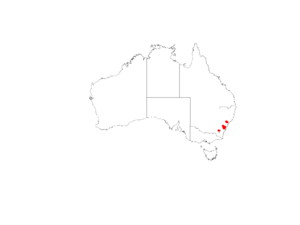Prostanthera rugosa facts for kids
Quick facts for kids Prostanthera rugosa |
|
|---|---|
| Scientific classification | |
| Genus: |
Prostanthera
|
| Species: |
rugosa
|
 |
|
| Occurrence data from AVH | |
The Prostanthera rugosa is a special kind of flowering plant. It belongs to the Lamiaceae family, which includes mint plants. This shrub is found only in a small part of New South Wales, Australia. It has a unique look with its thick, egg-shaped leaves and pretty mauve (purple-pink) flowers. These flowers often have a touch of white.
Meet the Rugged Mintbush
The Prostanthera rugosa is an openly-branched shrub. It can grow to be about 1 to 1.5 meters tall. Its branches are quite hairy, especially when they are young. They also have tiny glands that are attached directly to the stem without a stalk.
Leaves and Flowers
The leaves of this plant are shaped like an egg. They can also be narrow and egg-shaped. The top surface of the leaves feels hairy. Each leaf has two or three small bumps or lobes on its sides. They are usually 3 to 9 millimeters long and 2 to 5 millimeters wide. A short stalk, called a petiole, holds each leaf. This stalk is about 0.5 to 2 millimeters long.
The flowers grow where the leaves meet the stem. You'll find them near the ends of the branches. At the base of each flower, there are tiny leaf-like structures called bracteoles, less than 0.5 millimeters long.
The outer parts of the flower, called sepals, are 4 to 5 millimeters long. They form a tube that is 2 to 3 millimeters long. This tube has two lobes, with the upper one being 2 to 3 millimeters long. The petals are a lovely mauve color with a hint of white. They measure about 10 to 13 millimeters long. You can usually see this plant flowering from September to October.
How it Got its Name
The Prostanthera rugosa was first officially described in 1834. This was done by a botanist named George Bentham. He used notes from another botanist, Alan Cunningham. Cunningham had collected these plants near the Hunter River in New South Wales. Bentham then published this description in his book, Labiatarum Genera et Species.
Where it Grows
This special mintbush likes to grow in forests. You can find it in the Moss Vale area of New South Wales.

